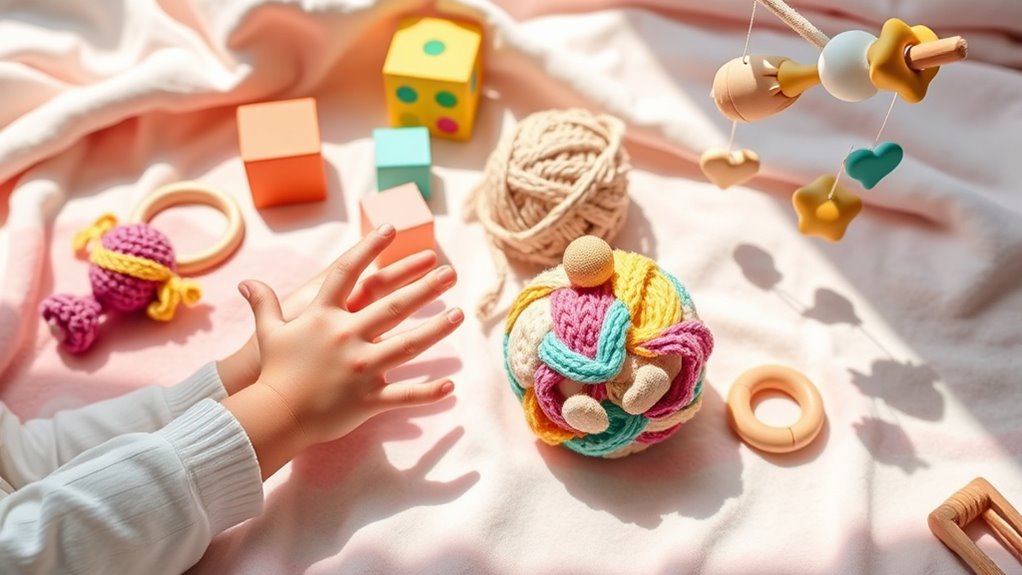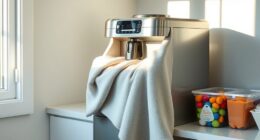Creating DIY baby toys is a fun and cost-effective way to spark your little one’s imagination and sensory development. You can easily whip up colorful crinkle paper boxes, homemade rattles, or even sensory bottles with rice and glitter. Not only do these projects engage your baby’s senses, but they also promote fine motor skills and cognitive growth. As you explore more ideas and techniques, you’ll find exciting ways to enhance your baby’s playtime experience.
Key Takeaways
- Create crinkle paper pull boxes to enhance fine motor skills and provide sensory exploration for your baby.
- Make musical rattles using filled containers for auditory stimulation and engaging sound play.
- Use empty tissue boxes with fabric strips to develop your baby’s pincer grasp and hand-eye coordination.
- Transform old pantyhose into sensory stockings filled with various textures for tactile exploration.
- Craft DIY glitter bottles with water, glitter, and glue for mesmerizing visual engagement during playtime.
Benefits of Homemade Baby Toys

When you decide to make homemade baby toys, you not only save money but also create unique playthings that can enhance your baby’s development.
DIY baby toys are cost-effective and allow you to craft engaging, safe items using everyday materials. These toys often incorporate bright colors and varying textures, making them fun for babies while considerably boosting sensory development. Incorporating natural materials into your DIY projects can further enhance the tactile experience for your baby. Additionally, creating these toys can be a great way to bond with your child as you explore interactive play areas together.
Crafting DIY baby toys is a budget-friendly way to create vibrant, textured playthings that enhance sensory development.
By recycling household items, you promote sustainability and turn ordinary objects into stimulating playthings. Plus, you can create customized toys tailored to your baby’s preferences and developmental needs, fostering a deeper connection during playtime.
Research shows that these sensory experiences are vital for developing fine motor skills and cognitive abilities in early childhood, making homemade baby toys a valuable resource for parents. Additionally, engaging in DIY projects can encourage sustainable practices that benefit the environment.
Easy DIY Toy Ideas for Babies
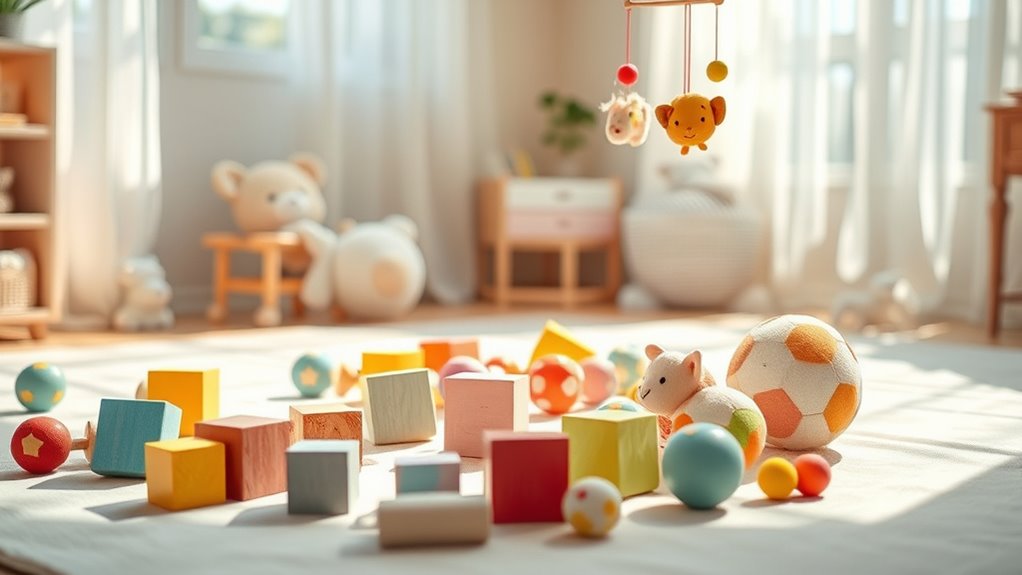
Creating easy DIY toys for babies can be a fun and rewarding experience for both you and your little one. You can make toys using common household items that spark curiosity and promote learning.
For instance, crinkle paper or tissue pull boxes enhance fine motor skills while providing sensory exploration. Homemade musical instruments, like rattles from filled containers, offer auditory stimulation and encourage creative play. Edible finger paints made from natural ingredients invite safe sensory experiences. Additionally, incorporating nutritious foods into your baby’s diet can further promote healthy development as they grow. Offering freshly squeezed juices can also provide essential vitamins that support growth.
Additionally, DIY sensory toys such as glitter bottles and scrunchy sound socks stimulate visual and auditory senses, supporting cognitive development. These projects aren’t only simple but also enjoyable to make, ensuring your baby has engaging toys tailored to their needs. Including whole foods in your baby’s diet can further promote healthy development as they grow.
Creative Sensory Play Activities

Creative sensory play activities are a fantastic way to engage your baby’s developing skills. You can create homemade musical instruments, explore various textures, and introduce vibrant colors to stimulate their senses. These activities not only entertain but also support important cognitive and motor development. Incorporating toys like Montessori-Inspired ThinkMax Matching Eggs can further enhance their cognitive skills through matching activities. Additionally, you can introduce omega-3 rich foods into their diet as they grow, which supports brain health and cognitive function. Including foods rich in dietary fiber like chia seeds can also aid in digestion, promoting overall health as they begin to explore new tastes.
Engaging Musical Instruments
Engaging your baby with homemade musical instruments not only sparks their curiosity but also enhances their sensory development. You can easily make fun DIY toys using everyday items. Here are some simple ideas:
| Instrument | Description |
|---|---|
| Homemade Rattles | Fill Pringles tins with stones, rice, or pasta for auditory stimulation. |
| Drum Kits | Transform milk formula tins with wooden spoons to encourage rhythm exploration. |
| Plastic Lid Bracelets | String plastic bottle lids on elastic for sound and movement experimentation. |
Other options include scrunchy sound socks filled with crinkly paper and click-click toys from old keyboards. These engaging musical instruments will keep your babies entertained while boosting their sensory skills! Additionally, DIY projects like these can foster imaginative play and creativity, aligning with the principles of holistic development found in Waldorf education.
Textured Sensory Exploration
While babies naturally explore their world through touch, textured sensory play activities can greatly enhance their tactile experiences. Incorporate squishy balls, crinkly paper, and various fabrics to stimulate tactile exploration and promote comfort.
These activities not only engage their senses but also encourage fine motor skills development. DIY sensory bottles filled with glitter, water, and clear glue offer visual and auditory engagement, sparking curiosity.
You can create scrunchy sound socks or textured discovery baskets to foster sensory integration, helping your baby develop their sense of touch, sight, and hearing.
For an added twist, use safe food items like sugar-free jello or ice to enhance taste exploration, expanding their sensory play and making it even more enjoyable.
Colorful Visual Stimulation
To promote healthy visual development in your baby, incorporating colorful and high-contrast toys into their playtime is essential. Brightly colored toys catch their attention and enhance visual tracking during their first year.
Creating homemade sensory bottles filled with water, glitter, and colorful beads offers mesmerizing visual stimulation that keeps them engaged.
DIY fabric toys featuring various textures and vibrant colors encourage tactile exploration while also stimulating their visual senses.
Incorporating contrasting colors in DIY play mats and mobiles helps them distinguish between different colors as their vision matures.
Safety Tips for Homemade Baby Toys
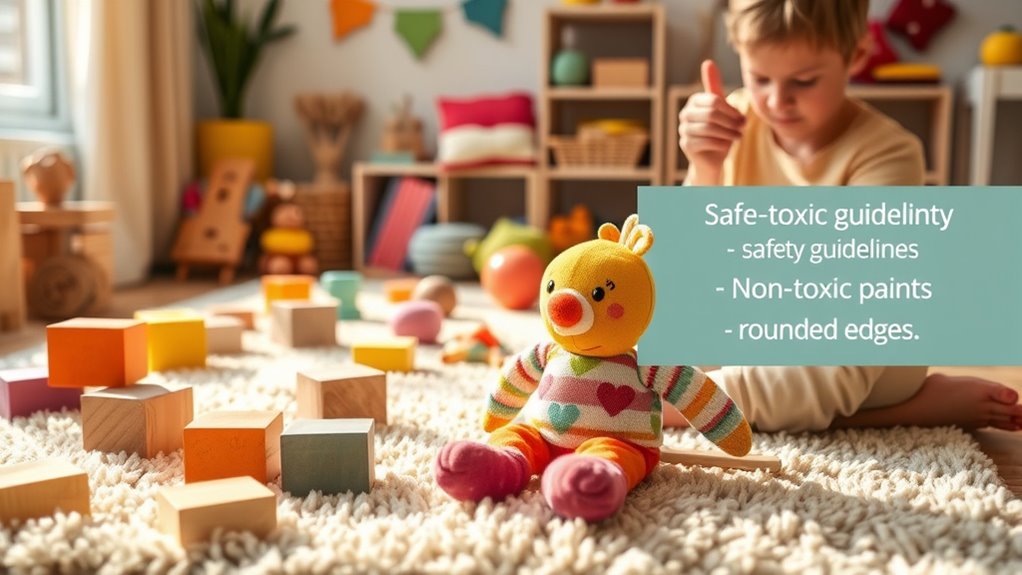
When creating homemade baby toys, it’s crucial to prioritize safety to guarantee your little one can explore and play without risks.
Always use non-toxic materials to protect their health. Choose appropriately sized toys and avoid small parts that could pose choking hazards, especially for babies under three years old.
Prioritize safety by using non-toxic materials and ensuring toys are appropriately sized to prevent choking hazards for young children.
Smooth all surfaces to eliminate sharp edges that might cause cuts or scrapes during play. Securely attach any strings or ribbons, keeping them short to prevent wrapping around your baby’s neck, and double-knot all attachments for durability.
Most importantly, supervise babies during playtime with DIY toys to quickly address any potential hazards and maintain safe exploration.
Engaging Projects Using Recyclable Materials
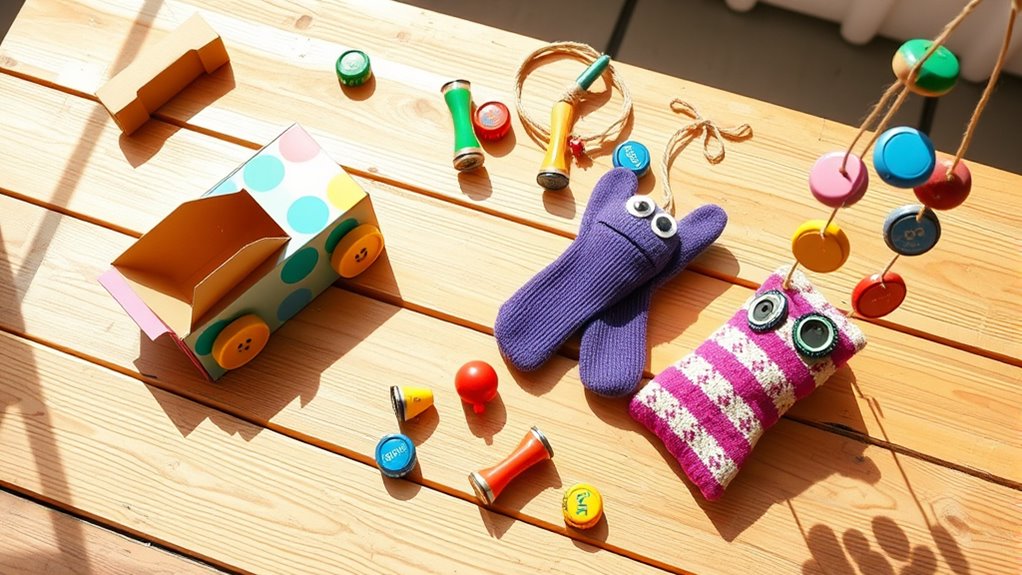
You can turn everyday household items into fun baby toys that spark curiosity and creativity.
By repurposing materials like old containers and cardboard, you’ll create engaging sensory play opportunities without breaking the bank.
Let’s explore some budget-friendly craft ideas that not only entertain but also support your baby’s development.
Repurposing Household Items
Repurposing household items offers countless opportunities to create engaging toys that spark your baby’s curiosity and support their development.
For instance, an old wallet filled with playing cards can keep them busy as they practice taking cards out and putting them back in, enhancing fine motor skills.
You can also transform empty makeup containers into fun and easy toys that promote hand-eye coordination as your baby explores opening and closing them.
An empty tissue box can house fabric strips instead of tissues, encouraging your little one to pull them out and strengthen their pincer grasp.
Additionally, a cardboard box can be a crawling tunnel, promoting physical development while they navigate through it.
These ideas make for simple, effective baby toys!
Sensory Play Opportunities
Creating engaging toys from household items is just the beginning of fostering your baby’s development through play. Sensory play opportunities using recyclable materials can be both fun and educational for babies and toddlers.
Here are some simple DIY projects you can try:
- Fill empty plastic bottles with rice or pasta for auditory stimulation.
- Make your own DIY glitter bottles with water, glitter, and a touch of glue for mesmerizing visuals.
- Transform old pantyhose into scrunchy sensory stockings filled with various textures for tactile exploration.
- Upcycle tissue boxes into pull toys packed with colorful fabric strips to enhance fine motor skills.
These soft toys not only entertain but also stimulate your little one’s senses, encouraging them to explore and learn!
Budget-Friendly Craft Ideas
While it might seem challenging to come up with engaging toys on a budget, countless ideas using recyclable materials can spark your child’s imagination. Upcycling everyday items like old containers and fabric scraps can yield safe DIY toys that stimulate sensory development.
For instance, using empty makeup containers or tissue boxes lets babies practice opening and closing, enhancing their fine motor skills. You can also create homemade sensory bottles filled with water, glitter, and small objects, providing visual enchantment.
Transform cardboard boxes into tunnels or playhouses to encourage crawling and exploration. Incorporating natural items like wool balls or measuring cups offers tactile experiences, making these budget-friendly projects not only fun but also beneficial for your little one’s growth.
Exploring Textures and Sounds
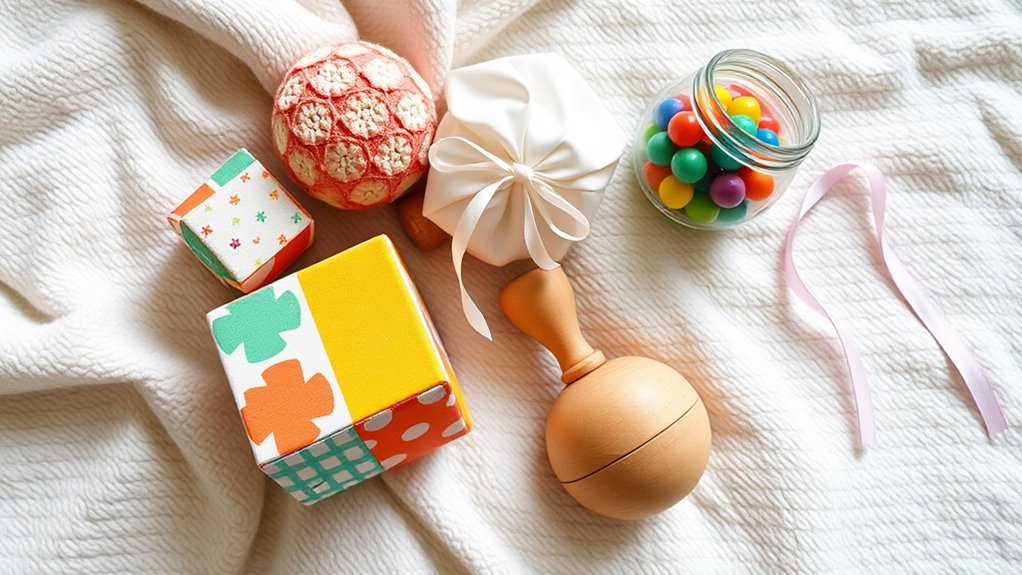
Babies thrive on sensory experiences, and exploring textures and sounds is essential for their development.
You can create engaging toys that incorporate tactile materials and auditory elements for stimulating sensory exploration. Here are some fun ideas:
- Use crinkle paper, like parchment cut into squares, for engaging crunch sounds as babies manipulate the toy.
- Make soft sensory blocks covered in various fabrics to enhance touch and comfort.
- Create homemade rattles filled with rice or stones to spark auditory engagement and curiosity.
- Transform everyday items, like empty containers filled with different textured materials, into sensory toys that encourage imaginative play.
These simple DIY toys can greatly enrich your baby’s sensory experience and promote cognitive growth!
Encouraging Motor Skills Through Play
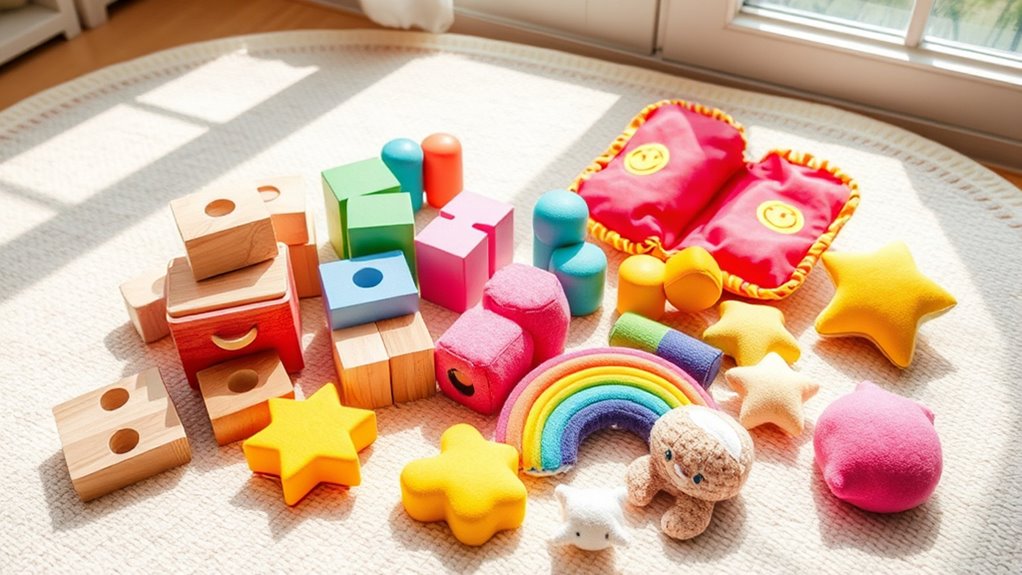
Engaging your little one in play not only brings joy but also plays an essential role in developing their motor skills. One simple-to-make activity is pulling fabric from a tissue box, which helps your child strengthen their pincer grasp.
Playtime is vital for your child’s motor skill development, like pulling fabric from a tissue box to enhance their pincer grasp.
Toys like crinkle paper and homemade shakers encourage exploration of sounds and textures, enhancing hand-eye coordination. Stacking and pouring with measuring cups filled with rice or lentils promotes hand strength and imaginative play.
Crawling through a cardboard tunnel boosts gross motor skills and spatial awareness. Plus, movement-based play, like laundry basket racers, fosters coordination and balance as your little one pushes or gets pushed around.
These fun activities are crucial during early childhood development!
Frequently Asked Questions
What Is an Easy Toy to Make?
An easy toy to make is a crinkle toy. You can sew squares of fabric around crinkly parchment paper, creating a fun sound that’ll engage your baby. It’s simple and requires minimal materials.
If you’re looking for something even easier, consider making a cardboard tunnel from old moving boxes. It encourages your little one to crawl, promoting their motor skills.
These toys aren’t only easy to create but also provide great sensory experiences!
How to Make a Low Cost Toy for Children Using Household Material?
Think of a chef whipping up a meal with whatever’s in the pantry. You can create low-cost toys using household materials just as creatively!
Grab an old wallet and fill it with playing cards for fine motor practice. Or, take an empty tissue box, cut fabric strips, and let your little one pull them out for fun.
Each item becomes a tool for learning, turning ordinary objects into extraordinary play experiences.
What Kind of Toys Objects Do Babies Prefer?
Babies prefer toys that are bright and colorful, as these catch their eye and keep them engaged.
They’re drawn to sound-producing toys like rattles or crinkly materials, which stimulate their auditory senses.
Textured toys also captivate them, promoting tactile exploration.
Lightweight and easy-to-grasp objects, such as soft blocks, help develop their fine motor skills.
Ultimately, they love toys they can manipulate, enhancing their coordination and understanding of their surroundings.
How Can I Play With My Baby Without Toys?
You might think playing with your baby requires a room full of toys, but that’s not true!
Explore everyday items around your home instead. Use old wallets or makeup containers for sensory play, or create a cardboard tunnel to encourage crawling. Fill jars with rice or lentils for scooping fun.
Crinkle paper can stimulate their hearing, while natural materials offer tactile experiences. You’ll be amazed at how much joy these activities can bring!
Conclusion
Making your own baby toys can be a rewarding experience, like crafting a cozy blanket from your grandma’s old quilt. Not only do homemade toys save money, but they also offer endless opportunities for creativity and bonding. By engaging in sensory play and using recyclable materials, you can spark your baby’s curiosity while ensuring safety. So grab those old fabric scraps and cardboard boxes—let’s create toys that entertain, educate, and nurture your little one’s growing mind!
